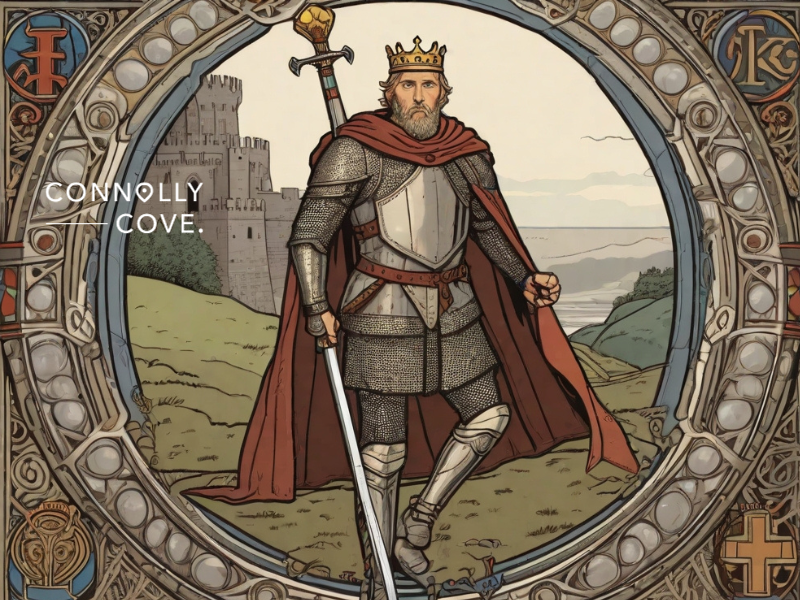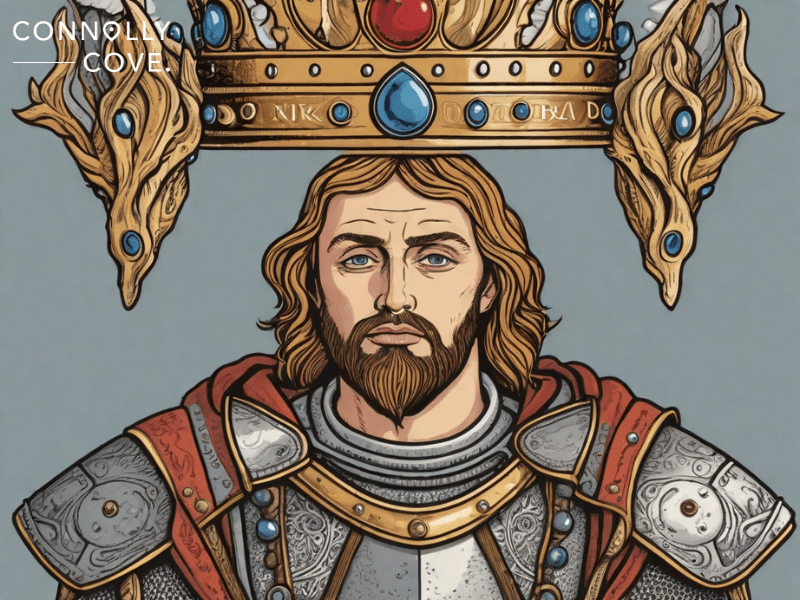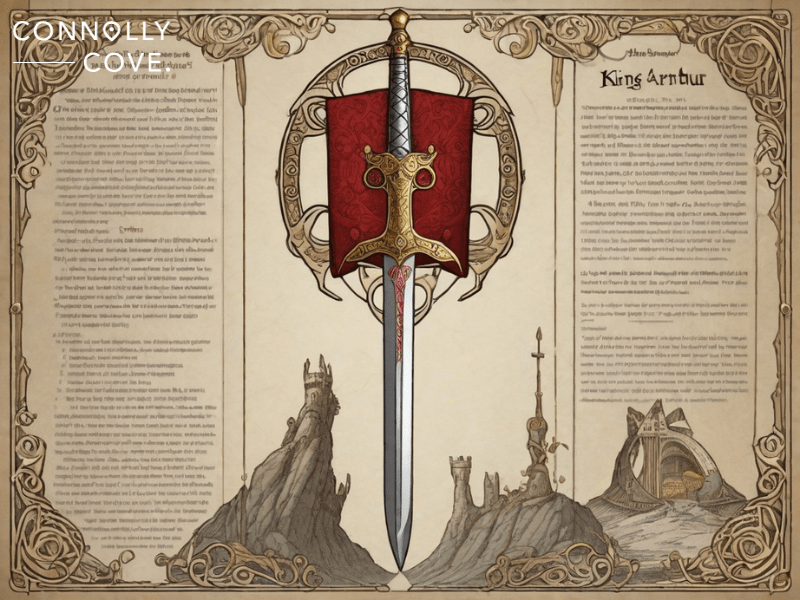In Search for King Arthur and the Story of the Legendary Sword

Updated On: November 10, 2023 by Noha Basiouny
Beneath the shadow of ancient stone ruins and across the green, surging hills of Britain, the legend of King Arthur has long stood as a towering figure in the pantheon of national myth. Straddling the line between history and fantasy, King Arthur’s tale has been told and retold through generations and gradually become a cornerstone of British cultural heritage, casting its spell over literature, art, and the collective imagination.
At the heart of this narrative tapestry is King Arthur himself, a figure who may have been forged out of the deeds of multiple heroes or the dreams of a nation in need of hope. The king, with his legendary fabled sword, his noble court, and the enigmatic wizard, has become synonymous with a golden age of both chivalry and bravery.
Yet, who was King Arthur, for real? Was he a genuine figure who defended Britain against the Saxon invaders or merely a fabrication of creative storytellers through the ages? The debate has raged for centuries, and the quest for the historical Arthur has long fascinated the crowds.
In this article, we shall take you on a journey to trace the origins of King Arthur’s legend from the earliest historical references that mentioned him, through the rich tapestry of medieval literature that clothed him in majesty, and into the modern era, where he continues to reign as a symbol of ideal kingship and heroism.
King Arthur: Man or Myth?

Anyone who has ever engaged with King Arthur’s legend may somewhat agree that he is one of the most enduring figures of Western culture and a symbol of courtesy and nobility.
Simply put, King Arthur was a brave and noble Brittonic, possibly Roman-affiliated, military leader who rallied the British people against the invading Anglo-Saxons sometime in the late fifth to early sixth centuries. As he went on to conquer much of Europe, King Arthur could establish a prosperous empire where he ruled with wisdom and justice.
That said, no one knows whether King Arthur was an actual historical figure or a work of art some writer’s wild imagination built. Such a debate has been ongoing for centuries, as the records that mentioned Arthur did not imply in any way that he once existed, nor did they claim the opposite. Even after a long, persistent search for evidence, what was found ironically supports both arguments.
This is pretty much like the controversy over the Iliad and the Odyssey of the great Greek poet Homer. In the end, we still do not know if Achilles and Odysseus were anything other than fiction.
Historical Records
King Arthur was frequently mentioned in some old Welsh historical records and chronicles. Some of them include the writings of Gildas and Nennius, two British monks who lived during the sixth and ninth centuries, respectively.
Another reference that mentions King Arthur was the Annales Cambriae, or the Annals of Wales, a combination of Latin chronicles assembled in the 12th century from different sources in Wales, which themselves date back to the mid-10th century.
However, these accounts are pretty vague and do not give any further biographical information about Arthur or any other reliable historical events. Yet, it was not long until King Arthur appeared once again in other records with what seems like a more comprehensive description.
The Historia Regum Britanniae, or the History of the Kings of Britain, was a historical account written by a Welsh Catholic clerk called Geoffrey of Monmouth, whose writings contributed much to the development of British historiography.
Geoffrey portrayed King Arthur comprehensively in a historical narrative that shaped the world he lived in very well. He also described Arthur as a noble king of Britain who defeated the Saxons and established a great empire.
However, Geoffrey was known to blend folklore, myth, and history and much of his work, despite being captivating and influential, was also controversial. In fact, many historians consider Geoffrey’s account of Arthur to be largely fictional, and they were not to take anything he wrote about King Arthur as the truth.
Examining Geoffery’s account of King Arthur pretty much tells the same thing. As the setting of that account is magical, one cannot tell whether or not Arthur himself was magical, too.
So, what exactly was that account like? How did Geoffrey portray Arthur?
History of the Kings of Britain
In the History of the Kings of Britain, King Arthur is depicted as the ideal medieval king, the monarch of a famous castle and a royal court that was a model of a utopian, just, and fair rule, which stood as the capital of King Arthur’s empire.
King Arthur ascended to the throne succeeding his father, Uther Pendragon, the king of Britain who, too, was a powerful and charismatic leader, a skilled warrior and a magician. Arthur’s wizard and dear advisor, Merlin, was a figure of great power and wisdom as well. Merlin actually played a pivotal role in Arthur taking over, probably by poisoning Uther to clear his son’s way to the throne.
Once he became king, Arthur spared no effort to secure his kingdom against the barbarian threats from the Saxons and then went on to conquer Norway, Denmark, and Gaul.
Included within this setting were also Guinevere, who was Arthur’s beautiful and graceful wife, and Mordred, Arthur’s nephew, who apparently did not like his uncle very much. Geoffrey recounted how Mordred betrayed Arthur in his absence by usurping the throne and marrying Guinevere. This led to the Battle of Camlann upon Arthur’s return, which brought about the collapse of Arthur’s empire and wrapped up his legend.
While this plot does sound pretty mythical, it is not far from reality. In fact, the exact same scenario happened in Afghanistan, which, by the way, sparked the inferno that has swept through the entire country.
In 1973, when King Mohamed Zahir Shah was in Italy for a necessary eye surgery, his cousin Mohammad Daoud Khan led a coup d’état, overthrew the monarchy, and announced himself the first president of the new Republic of Afghanistan. This provoked a chain of events that led to the Afghan-Soviet War, the rise of al-Qaeda and Taliban, and the US invasion, which all eventually led to the collapse of the country.
Just like how Daoud Khan’s coup d’état brought Afghanistan to an end in real life, Mordred’s betrayal of Arthur entailed a fierce confrontation that eventually devastated the entire empire and led to the collapse of Arthur’s monarchy.
According to Geoffery, Arthur killed Mordred but was himself gravely wounded. So he was taken to the Isle of Avalon, a beautiful legendary island that was ruled by his witchy sister, to heal. This is precisely where Geoffrey chose to end his account and left Arthur’s fate undetermined. Did he heal and go back to his castle? Did he bleed to death? Well, no one knows.
Literary References

Geoffery did a great job creating the magical realm of King Arthur, but he did not point out which, or if any, of the events he narrated were true. Yet, that did not seem to be a problem at the time at all, as many were so blown away by this mystic setting that it became the basis for more and more legends.
In the centuries that followed, numerous literary tapestries emerged, featuring and expanding the legend of the king even more. Writers added in more characters, battles, betrayal and lots and lots of captivating dramatic events. Here are some key works that have contributed significantly to the Arthurian legend:
- Arthurian Romances: A 12th-century collection of tales of the Arthurian knights written by French poet Chrétien dae Troyes, who introduced the character of Lancelot and the search for the Holy Grail into the legend.
- Lancelot-Grail Cycle: A series of Old French prose works from the 13th century that expanded the stories of the Arthurian world, including the backstory of the Holy Grail and the doomed love affair between Lancelot and Guinevere.
- Le Morte d’Arthur: This is perhaps the most famous Arthurian text, completed in the 15th century by Sir Thomas Malory, which compiles and interprets many of the existing Arthurian legends into a single narrative.
- Idylls of the King: A series of narrative poems from the 19th century by Alfred Lord Tennyson that reinterprets the Arthurian legends for the Victorian era, focusing on themes of romance, heroism, and morality.
- The Once and Future King: A 20th-century novel by T.H. White that is a reworking of traditional Arthurian legends, from Arthur’s childhood to the end of his reign, and inspired Disney‘s “The Sword in the Stone.”
- The Mists of Avalon: A feminist retelling of the Arthurian legends by Marion Zimmer Bradley, told from the perspective of the women in the story, which was published in the 1980s.
Archaeological Sites
In an effort to find the truth about King Arthur, scholars, archaeologists and enthusiasts started excavating the sites that were mentioned in the legends, looking for evidence that may prove or disprove the king’s existence. Although the legendary nature of the sources made no site definitively linked to the historical Arthur, several places have become entwined with the Arthurian legend.
Here are some notable archaeological sites associated with the lore of King Arthur:
- Tintagel Castle: Perched on the cliffs of Cornwall, Tintagel is traditionally considered the birthplace of King Arthur. Archaeological excavations have revealed a high-status settlement dating from the fifth to the seventh centuries, along with a medieval castle built by Richard Earl of Cornwall in the 13th century, which capitalises on the Arthurian legends.
- Glastonbury Abbey: Mythically linked to the Isle of Avalon, Glastonbury Abbey is where the alleged graves of King Arthur and Queen Guinevere were reportedly found by the monks in the 12th century. The ruins of the abbey still stand, although the grave itself has been lost to history, and the story is considered by many to be a medieval fabrication.
- Cadbury Castle: No, this was not an old chocolate factory but an ancient hill fort in Somerset. Cadbury Castle has been identified by some as the site of Arthur’s fairy castle, Camelot. Archaeological evidence indicates that it was indeed fortified in the post-Roman period, but there is no direct evidence connecting it to Arthur.
- The Round Table: Although not an ancient site, the Great Hall of Winchester Castle houses a round table which has been painted with the names of Arthur’s knights. It was created in the late medieval period and is a testament to the enduring popularity of the Arthurian legend.
Another interesting thing about Arthur’s legend is how it depicts the construction of the great monument of Stonehenge.
As the story goes, the stones were originally part of a structure in Ireland called the Giants’ Ring. After a massacre of British nobles by the Saxons, Arthur’s father wanted to erect a monument in their honour. Merlin the wizard then led an expedition to bring the Giants’ Ring to Britain, where they were reassembled into what we now know as Stonehenge as a memorial to the fallen nobles.
King Arthur’s Sword

King Arthur’s sword is perhaps the most famous legendary sword in Western literature and one that symbolises the king’s divine kingship and great power. Just like Arthur himself, the earliest origins of the sword are difficult to trace with certainty due to the blending of historical and mythological accounts over the centuries, and its story has been embellished and adapted through the ages.
The sword was first mentioned under the Latin name “Caliburnus” (or “Caliburn”) in Geoffrey of Monmouth’s History of the Kings of Britain. Despite that, Geoffrey did not explain in his fantasy how King Arthur came to possess his famous sword, but multiple writers who helped enrich the legend of King Arthur did come up with multiple versions of the story. Here are some of them:
- The Sword in the Stone: In one of the most famous stories, mainly popularised by Sir Thomas Malory’s 15th-century book “Le Morte d’Arthur”, Merlin the wizard had previously placed the sword in the stone, declaring that whoever could pull it out would be the true king. Many tried and failed to remove the sword, but young Arthur succeeded where others could not, thus revealing his royal lineage and destiny.
- The Lady of the Lake: In other stories, Arthur received his sword from the Lady of the Lake. After his first sword (which may or may not be the same as the Sword in the Stone) is damaged, Merlin took Arthur to a mystical lake. There, a hand emerged from the water, holding aloft the brilliant sword, offering it to Arthur, and in doing so, granted him the sovereignty of Britain.
Name
Instead of Caliburnus, the name “Excalibur” was later used in the Arthurian romances, including the works of Chrétien dae Troyes, and became more widely popularised in later Arthurian literature, including the aforementioned 15th-century “Le Morte d’Arthur” by Sir Thomas Malory, where Excalibur is differentiated from the Sword in the Stone.
The evolution of the name from “Caliburnus” to “Excalibur” reflects the passage of the Arthurian legend through different languages and cultural influences, particularly from Latin to Old French and then to Middle English.
Magical Properties
Geoffrey had previously described Caliburnus just as “an excellent sword made in the Isle of Avalon,” the mystical island we mentioned earlier. But in later French romances, and as more stories on how Arthur was granted it came out, more properties were given to the magical sword.
For instance, some stories claim that Excalibur could shine so brightly that it blinded Arthur’s enemies. It was unbreakable or so sharp that it could cut through iron and stone with ease and give its bearer a supernatural edge in battle, ensuring victory so long as the cause was just.
According to some legends, Excalibur also had the power to heal its bearer’s wounds, particularly when drawn or sheathed. This not only made Arthur formidable in battle but also resilient. Yet, other legends stated that it was Excalibur’s scabbard that could protect the one who possessed it from physical harm. Whoever the bearer was could not bleed from wounds or would not bleed to death, essentially rendering them invulnerable.
In the legend, the fate of Excalibur is as significant as its origin. Before Arthur went to his final rest (often on the Isle of Avalon), he ordered one of his knights to return Excalibur to the lake from which it had come, thus restoring the sword to its mystical source and maintaining the cycle of birth, death, and rebirth that was a common theme in mythology.
In the search for a historical Arthur, we may never find concrete evidence to satisfy our curiosity. However, the symbolic King Arthur that we know through literature and popular culture transcends the need for historical validation. He stands as an archetype of the ideal ruler, a beacon of hope against the darkness, and a figure that inspires leaders, storytellers, and dreamers.
Thus, King Arthur, Excalibur in hand, remains not in the stone of our landscapes but in the bedrock of our collective imagination—a king for all ages, as immortal as the stories we tell. As we conclude this exploration into the fabled life of King Arthur, we are reminded that legends, in their greatest form, are not bound by the strictures of history; instead, they are etched in the very human need to believe in something greater than ourselves, something eternally just, brave, and true.






